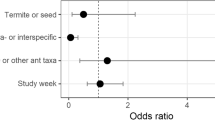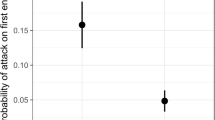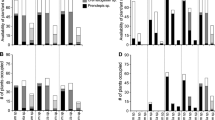Abstract
A wide variety of animal communities are organized into interspecific dominance hierarchies associated with the control and harvest of food resources. Interspecific dominance relationships are commonly found to be linear. However, dominance relations within communities can form a continuum ranging from intransitive networks to transitive, linear dominance hierarchies. How interference competition affects community structure depends on the configuration of the dominance interactions among the species. This study explores how resource size and the trait-mediated indirect effect (TMIE) specialist phorid fly parasitoids exert on interference competition, affect the transitive nature of competitive interactions in an assemblage of woodland ants. I quantify the linearity of networks of interactions associated with large and small food resources in the presence and absence of phorid parasitoids. Two distinct, significantly linear dominance hierarchies exist within the ant assemblage depending on the size of the disputed resource. However, the presence of phorid fly parasitoids eliminates the linearity of both dominance hierarchies. The host’s phorid defense behaviors reduce the competitive asymmetries between the host and its subdominant competitors, increasing the indeterminacy in the outcome of competitive interactions. Thus, both resource size variation and phorid-induced TMIEs appear to facilitate coexistence in assemblages of scavenging ants.




Similar content being viewed by others
References
Abrams PA (1995) Implications of dynamically variable traits for identifying, classifying, and measuring direct and indirect effects in ecological communities. Am Nat 146:112–134
Adams ES, Traniello JFA (1981) Chemical interference competition by Monomorium minimum (Hymenoptera: Formicidae). Oecologia 51:265–270
Andersen AN (1992) Regulation of “momentary” diversity by dominant species in exceptionally rich ant communities of the Australian seasonal tropics. Am Nat 140:401–420
Appleby MC (1983) The probability of linearity in hierarchies. Anim Behav 31:600–608
Bestelmeyer BT (2000) The trade-off between thermal tolerance and behavioral dominance in a subtropical South American ant community. J Anim Ecol 69:998–1009
Brown BV, Feener DH Jr (1991) Behavior and host location cues of Apocephalus paraponerae (Diptera: Phoridae) a parasitoid of the giant tropical ant, Paraponera clavata (Hymenoptera: Formicidae). Biotropica 23:182–187
Buschinger A, Maschwitz U (1984) Defensive behavior and defensive mechanisms in ants. In: Hermann HR (ed) Defensive mechanisms in social insects. Praeger, New York, pp 95–150
Buss LW (1980) Competitive intransitivity and size-frequency distributions of interacting populations. Proc Natl Acad Sci 77:5355–5359
Buss LW, Jackson JBC (1979) Competition networks: nontransitive competitive relationships in cryptic coral reef environments. Am Nat 113:223–234
Cerdá X et al (1997) Thermal disruption of transitive hierarchies in Mediterranean ant communities. J Anim Ecol 66:363–374
Cerdá X et al (1998a) Critical thermal limits in Mediterranean ant species: trade-off between mortality risk and foraging performance. Funct Ecol 12:45–55
Cerdá X et al (1998b) Prey size reverses the outcome of interference interactions of scavenger ants. Oikos 82:99–110
Connell JH (1978) Diversity in tropical rain forests and coral reefs. Science 199:1302–1310
Cotton PA (1998) Temporal partitioning of a floral resource by territorial hummingbirds. Ibis 140:647–653
Daily GC, Ehrlich PR (1994) Influence of social status on individual foraging and community structure in a bird guild. Oecologia 100:153–165
Detrain C (1990) Field study on foraging by the polymorphic ant species, Pheidole pallidula. Insect Soc 37:315–332
Disney RHL (1994) Scuttle flies: the Phoridae. Chapman and Hall, London
Feener DH Jr (1981) Competition between ant species: outcome controlled by parasitic flies. Science 214:815–817
Feener DH Jr et al (1996) Specialized parasitoid attracted to a pheromone of ants. Anim Behav 51:61–66
Feener DH Jr (2000) Is the assembly of ant communities mediated by parasitoids? Oikos 90:79–88
Feener DH Jr, Brown BV (1992) Reduced foraging of Solenopsis geminata (Hymenoptera: Formicidae) in the presence of parasitic Pseudacteon spp. (Diptera: Phoridae). Ann Entomol Soc Am 85:80–84
Feener DH Jr, Brown BV (1997) Diptera as parasitoids. Annu Rev Entomol 42:73–97
Fellers JH (1987) Interference and exploitation in a guild of woodland ants. Ecology 68:1466–1478
Folgarait PJ, Gilbert LE (1999) Phorid parasitoids affect foraging activity of Solenopsis richteri under different availability of food in Argentina. Ecol Entomol 24:163–173
Gaymer CF, et al (2002) Effect of intra- and interspecific interactions on the feeding behavior of two subtidal sea stars. Mar Ecol Prog Ser 232:149–162
Gilpin ME (1975) Limit cycles in competition communities. Am Nat 109:51–60
Gurevitch J, et al (1992) A meta-analysis of competition in field experiments. Am Nat 140:539–572
Harris PM (1996) Competitive equivalence in a community of lichens on rock. Oecologia 108:663–668
Hodge S, Arthur W (1997) Asymmetric interactions between species of seaweed fly. J Anim Ecol 66:743–754
Hölldobler B, Wilson EO (1990) The ants. Belknap Press of Harvard University Press, Cambridge, Mass., USA
Holway DA (1999) Competitive mechanisms underlying the displacement of native ants by the invasive argentine ant. Ecology 80:238–251
Hubbell SP (2001) The unified neutral theory of biodiversity and biogeograhy. Princeton University Press, Princeton, N.J.
Jackson JBC, Buss L (1975) Allelopathy and spatial competition among coral reef invertebrates. Proc Natl Acad Sci 72:5160–5163
JMP (2000) JMP Statistics and graphics guide, Version 4, 4th edn. SAS Institute, Cary, N.C.
Kaspari M (1996) Worker size and seed size selection by harvester ants in a Neotropical forest. Oecologia 105:397–404
LeBrun EG, Feener DH Jr (2002) Linked indirect effects in ant–phorid interactions: impacts on ant assemblage structure. Oecologia 133:599–607
Morrison LW (1996) Community organization in a recently assembled fauna: the case of Polynesian ants. Oecologia 107:243–256
Morrison LW (1999) Indirect effects of phorid fly parasitoids on the mechanisms of interspecific competition among ants. Oecologia 121:113–122
Morrison LW (2000) Mechanisms of Pseudacteon parasitoid (Diptera: Phoridae) effects on exploitative and interference competition in host Solenopsis ants (Hymenoptera: Formicidae). Ann Entomol Soc Am 93:841–849
Morrison LW et al (2000) Ecological interactions of Pseudacteon parasitoids and Solenopsis ant hosts: environmental correlates of activity and effects on competitive hierarchies. Ecol Entomol 25:433–444
Orr MR, et al (1995) Flies suppress fire ants. Nature 373:292
Orr MR, Seike SH (1998) Parasitoids deter foraging by Argentine ants (Linepithema humile) in their native habitat in Brazil. Oecologia 117:420–425
Palmer TM, et al (2000) Short-term dynamics of an acacia ant community in Laikipia, Kenya. Oecologia 123:425–435
Pimm SL, Pimm JW (1982) Resource use, competition, and resource availability in Hawaiian honey creepers. Ecology 63:1468–1480
Porter SD et al (1995) Solenopsis (Hymenoptera: Formicidae) fire ant reactions to attacks of Pseudacteon flies (Diptera: Phoridae) in southeastern Brazil. Ann Entomol Soc Am 88:570–575
Sanders NJ, Gordon DM (2003) Resource-dependent interactions and the organization of desert ant communities. Ecology 84:1024–1031
Savolainen R (1991) Interference by wood ant influences size selection and retrieval rate of prey by Formica fusca. Behav Ecol Sociobiol 28:1–7
Savolainen R, Vepsäläinen K (1988) A competition hierarchy among boreal ants: impacts on resource partitioning and community structure. Oikos 51:135–155
Savolainen R, Vepsäläinen K (1989) Niche differentiation of ant species within territories of the wood ant Formica polyctena. Oikos 56:3–16
Schoener TW (1983) Field experiments on interspecific competition. Am Nat 122:240–285
Taniguchi Y, Nakano S (2000) Condition-specific competition: implications for the altitudinal distribution of stream fishes. Ecology 81:2027–2039
Toft CA (1984) Resource shifts in bee flies (Bombylidae): interactions among species determine choice of resources. Oikos 43:104–112
Traniello JFA (1983) Social organization and foraging success in Lasius neoniger (Hymenoptera: Formicidae): behavioral and ecological aspects of recruitment communication. Oecologia 59:94–100
Vance RN (1985) The stable coexistence of two competitors for one resource. Am Nat 126:72–86
Vries H de (1995) An improved test of linearity in dominance hierarchies containing unknown or tied relationships. Anim Behav 50:1375–1389
Vries H de (1998) Finding a dominance order most consistent with a linear hierarchy: a new procedure and review. Anim Behav 55:827–843
Werner EE, Peacor SD (2003) A review of trait-mediated indirect interactions in ecological communities. Ecology 84:1083–1100
Wilson EO (1984) The relation between caste ratios and division of labor in the ant genus Pheidole (Hymenoptera: Formicidae). Behav Ecol Sociobiol 16:89–98
Acknowledgements
This research benefited greatly from extensive discussions with D. Feener, E. Lyon, and J. Piasecke provided assistance in the field. F. Adler, P. Coley, D. Clayton, D. Holway, M. Lefebvre, E. Wilkinson, and two anonymous reviewers gave constructive criticism of the manuscript. B. Brown assisted in phorid identification and provided criticism on the manuscript. Stefan Cover identified ant species. K. Krejs’ support and patience were invaluable. The support of the American Museum of Natural History’s Southwestern Research Station and its staff greatly facilitated this research. A NSF Graduate Fellowship and a NSF Dissertation Improvement Grant to E.G. LeBrun funded this research.
Author information
Authors and Affiliations
Corresponding author
Rights and permissions
About this article
Cite this article
LeBrun, E.G. Who is the top dog in ant communities? Resources, parasitoids, and multiple competitive hierarchies. Oecologia 142, 643–652 (2005). https://doi.org/10.1007/s00442-004-1763-4
Received:
Accepted:
Published:
Issue Date:
DOI: https://doi.org/10.1007/s00442-004-1763-4




